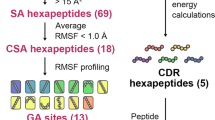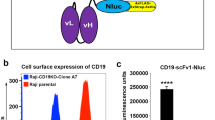Abstract
The anti-p185her2/neu peptidomimetic (AHNP) is a small exo-cyclic peptide derived from the anti-p185her2/neu rhumAb 4D5 (h4D5). AHNP mimics many but not all of the antitumor characteristics exhibited by h4D5. However, the pharmacokinetic profiles of AHNP are less than optimal for therapeutic or diagnostic purposes. To improve the binding affinity to p185her2/neu and the antitumor efficacy, we have engineered a fusion protein containing AHNP and a nonimmunoglobulin protein scaffold, streptavidin (SA). The recombinant protein, AHNP-SA (ASA) bound to p185her2/neu with high affinity, inhibited the proliferation of p185her2/neu-overexpressing cells, and reduced tumor growth induced by p185her2/neu-transformed cells. These data suggest that the bacterially produced tetrameric ASA can be used as an antibody-surrogate molecule. This class of molecule will play a role in the diagnosis and treatment of p185her2/neu-related tumors. Our studies establish a general principle by which a small biologically active synthetic exo-cyclic peptide can be engineered to enhance functional aspects by structured oligomerization and can be produced recombinantly using bacterial expression.
This is a preview of subscription content, access via your institution
Access options
Subscribe to this journal
Receive 50 print issues and online access
$259.00 per year
only $5.18 per issue
Buy this article
- Purchase on Springer Link
- Instant access to full article PDF
Prices may be subject to local taxes which are calculated during checkout






Similar content being viewed by others
References
Berezov A, Chen J, Liu Q, Zhang HT, Greene MI, Murali R . (2002). J Biol Chem 277l: 28330–28339.
Berezov A, Zhang HT, Greene MI, Murali R . (2001). J Med Chem 44l: 2565–2574.
Bruck C, Co MS, Slaoui M, Gaulton GN, Smith T, Fields BN et al. (1986). Proc Natl Acad Sci USA 83l: 6578–6582.
Chinol M, Casalini P, Maggiolo M, Canevari S, Omodeo ES, Caliceti P et al. (1998). Br J Cancer 78l: 189–197.
Cohen JA, Weiner DB, More KF, Kokai Y, Williams WV, Maguire Jr HC et al. (1989). Oncogene 4l: 81–88.
Di Fiore PP, Pierce JH, Fleming TP, Hazan R, Ullrich A, King CR et al. (1987). Cell 51l: 1063–1070.
Drebin JA, Link VC, Greene MI . (1988). Oncogene 2l: 387–394.
Drebin JA, Link VC, Stern DF, Weinberg RA, Greene MI . (1985). Cell 41l: 697–706.
Drebin JA, Link VC, Stern DF, Weinberg RA, Greene MI . (1986). Sympn Fund Cancer Res 38l: 277–289.
Drebin JA, Stern DF, Link VC, Weinberg RA, Greene MI . (1984). Nature 312l: 545–548.
Farlow SJ, Wang RJ, Pandori MW, Sano T . (2002) 516l: 197–200.
Hansen MB, Nielsen SE, Berg K . (1989) 119l: 203–210.
Hudson PJ, Souriau C . (2003). Nat Med 9l: 129–134.
Jurado P, Ritz D, Beckwith J, de Lorenzo V, Fernandez LA . (2002). J Mol Biol 320l: 1–10.
Kalofonos HP, Rusckowski M, Siebecker DA, Sivolapenko GB, Snook D, Lavender JP et al. (1990). J Nucl Med 31l: 1791–1796.
Kern JA, Schwartz DA, Nordberg JE, Weiner DB, Greene MI, Torney L et al. (1990). Cancer Res 50l: 5184–5187.
Kobayashi T, Ito K . (1999). EMBO J 18l: 1192–1198.
Kokai Y, Wada T, Myers JN, Brown VI, Dobashi K, Cohen J et al. (1988). Princess Takamatsu Symp 19l: 45–57.
Lodato RF, Maguire HC, Jr, Greene MI, Weiner DB, LiVolsi VA . (1990). Mod Pathol 3l: 449–454.
Maynard J, Georgiou G . (2000). Ann Rev Biomed Eng 2l: 339–376.
Meyer DL, Schultz J, Lin Y, Henry A, Sanderson J, Jackson JM et al. (2001). Protein Sci 10l: 491–503.
Murali R, Greene MI . (1998). Immunol Res 17l: 163–169.
Park BW, Zhang HT, Wu C, Berezov A, Zhang X, Dua R et al. (2000). Nat Biotechnol 18l: 194–198.
Proba K, Honegger A, Pluckthun A . (1997). J Mol Biol 265l: 161–172.
Rosebrough SF . (1993). Nucl Med Biol 20l: 663–668.
Slamon DJ, Godolphin W, Jones LA, Holt JA, Wong SG, Keith DE et al. (1989). Science 244l: 707–712.
Sliwkowski MX, Lofgren JA, Lewis GD, Hotaling TE, Fendly BM, Fox JA . (1999). Sem Oncol 26l: 60–70.
Williams TM, Weiner DB, Greene MI, Maguire Jr HC . (1991). Pathobiology 59l: 46–52.
Williams WV, Moss DA, Kieber-Emmons T, Cohen JA, Myers JN, Weiner DB et al. (1989). Proc Natl Acad Sci USA 86l: 5537–5541.
Zhang H, Cheng X, Richter M, Greene MI . (2006). Nat Med 12: 473–477.
Acknowledgements
This work was partially funded by grant from NCI (5P01 CA 89480). We thank Mayosha H Mendis for her technical support in the purification of ASA.
Author information
Authors and Affiliations
Corresponding author
Rights and permissions
About this article
Cite this article
Masuda, K., Richter, M., Song, X. et al. AHNP-streptavidin: a tetrameric bacterially produced antibody surrogate fusion protein against p185her2/neu. Oncogene 25, 7740–7746 (2006). https://doi.org/10.1038/sj.onc.1209745
Received:
Revised:
Accepted:
Published:
Issue Date:
DOI: https://doi.org/10.1038/sj.onc.1209745
Keywords
This article is cited by
-
Co-expression of Dsb proteins enables soluble expression of a single-chain variable fragment (scFv) against human type 1 insulin-like growth factor receptor (IGF-1R) in E. coli
World Journal of Microbiology and Biotechnology (2014)



